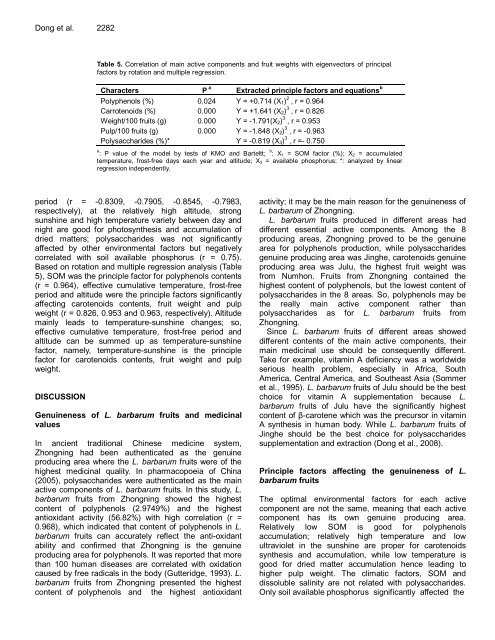Download Complete Issue - Academic Journals
Download Complete Issue - Academic Journals
Download Complete Issue - Academic Journals
Create successful ePaper yourself
Turn your PDF publications into a flip-book with our unique Google optimized e-Paper software.
Dong et al. 2282<br />
Table 5. Correlation of main active components and fruit weights with eigenvectors of principal<br />
factors by rotation and multiple regression.<br />
Characters P a Extracted principle factors and equations b<br />
Polyphenols (%) 0.024 Y = +0.714 (X1) 2 , r = 0.964<br />
Carrotenoids (%) 0.000 Y = +1.641 (X2) 3 , r = 0.826<br />
Weight/100 fruits (g) 0.000 Y = -1.791(X2) 3 , r = 0.953<br />
Pulp/100 fruits (g) 0.000 Y = -1.848 (X2) 3 , r = -0.963<br />
Polysaccharides (%)* Y = -0.819 (X3) 3 , r =- 0.750<br />
a : P value of the model by tests of KMO and Barteltt; b : X1 = SOM factor (%); X2 = accumulated<br />
temperature, frost-free days each year and altitude; X3 = available phosphorus; *: analyzed by linear<br />
regression independently.<br />
period (r = -0.8309, -0.7905, -0.8545, -0.7983,<br />
respectively), at the relatively high altitude, strong<br />
sunshine and high temperature variety between day and<br />
night are good for photosynthesis and accumulation of<br />
dried matters; polysaccharides was not significantly<br />
affected by other environmental factors but negatively<br />
correlated with soil available phosphorus (r = 0.75).<br />
Based on rotation and multiple regression analysis (Table<br />
5), SOM was the principle factor for polyphenols contents<br />
(r = 0.964), effective cumulative temperature, frost-free<br />
period and altitude were the principle factors significantly<br />
affecting carotenoids contents, fruit weight and pulp<br />
weight (r = 0.826, 0.953 and 0.963, respectively). Altitude<br />
mainly leads to temperature-sunshine changes; so,<br />
effective cumulative temperature, frost-free period and<br />
altitude can be summed up as temperature-sunshine<br />
factor, namely, temperature-sunshine is the principle<br />
factor for carotenoids contents, fruit weight and pulp<br />
weight.<br />
DISCUSSION<br />
Genuineness of L. barbarum fruits and medicinal<br />
values<br />
In ancient traditional Chinese medicine system,<br />
Zhongning had been authenticated as the genuine<br />
producing area where the L. barbarum fruits were of the<br />
highest medicinal quality. In pharmacopoeia of China<br />
(2005), polysaccharides were authenticated as the main<br />
active components of L. barbarum fruits. In this study, L.<br />
barbarum fruits from Zhongning showed the highest<br />
content of polyphenols (2.9749%) and the highest<br />
antioxidant activity (56.82%) with high correlation (r =<br />
0.968), which indicated that content of polyphenols in L.<br />
barbarum fruits can accurately reflect the anti-oxidant<br />
ability and confirmed that Zhongning is the genuine<br />
producing area for polyphenols. It was reported that more<br />
than 100 human diseases are correlated with oxidation<br />
caused by free radicals in the body (Gutteridge, 1993). L.<br />
barbarum fruits from Zhongning presented the highest<br />
content of polyphenols and the highest antioxidant<br />
activity; it may be the main reason for the genuineness of<br />
L. barbarum of Zhongning.<br />
L. barbarum fruits produced in different areas had<br />
different essential active components. Among the 8<br />
producing areas, Zhongning proved to be the genuine<br />
area for polyphenols production, while polysaccharides<br />
genuine producing area was Jinghe, carotenoids genuine<br />
producing area was Julu, the highest fruit weight was<br />
from Numhon. Fruits from Zhongning contained the<br />
highest content of polyphenols, but the lowest content of<br />
polysaccharides in the 8 areas. So, polyphenols may be<br />
the really main active component rather than<br />
polysaccharides as for L. barbarum fruits from<br />
Zhongning.<br />
Since L. barbarum fruits of different areas showed<br />
different contents of the main active components, their<br />
main medicinal use should be consequently different.<br />
Take for example, vitamin A deficiency was a worldwide<br />
serious health problem, especially in Africa, South<br />
America, Central America, and Southeast Asia (Sommer<br />
et al., 1995). L. barbarum fruits of Julu should be the best<br />
choice for vitamin A supplementation because L.<br />
barbarum fruits of Julu have the significantly highest<br />
content of β-carotene which was the precursor in vitamin<br />
A synthesis in human body. While L. barbarum fruits of<br />
Jinghe should be the best choice for polysaccharides<br />
supplementation and extraction (Dong et al., 2008).<br />
Principle factors affecting the genuineness of L.<br />
barbarum fruits<br />
The optimal environmental factors for each active<br />
component are not the same, meaning that each active<br />
component has its own genuine producing area.<br />
Relatively low SOM is good for polyphenols<br />
accumulation; relatively high temperature and low<br />
ultraviolet in the sunshine are proper for carotenoids<br />
synthesis and accumulation, while low temperature is<br />
good for dried matter accumulation hence leading to<br />
higher pulp weight. The climatic factors, SOM and<br />
dissoluble salinity are not related with polysaccharides.<br />
Only soil available phosphorus significantly affected the

















